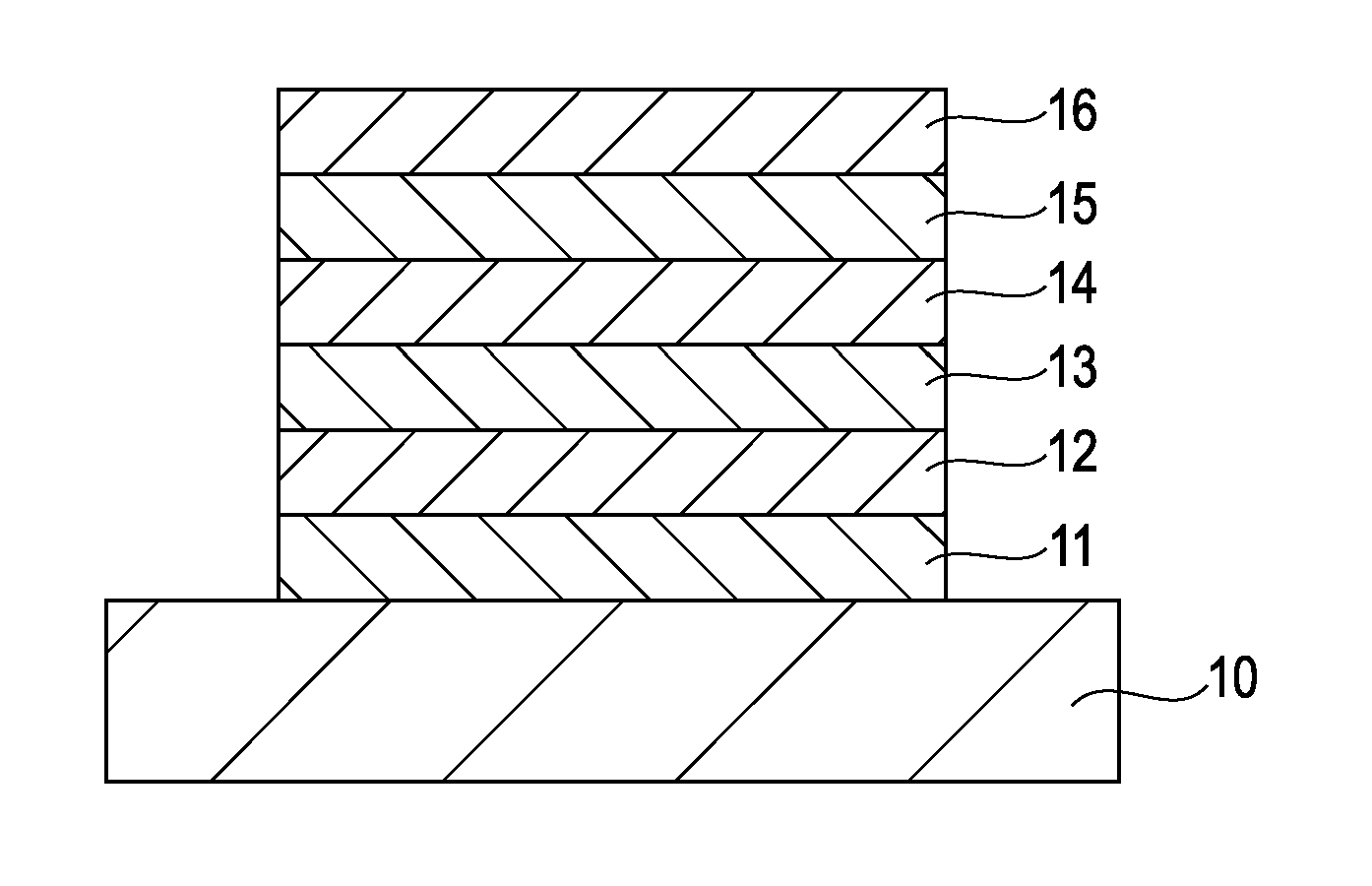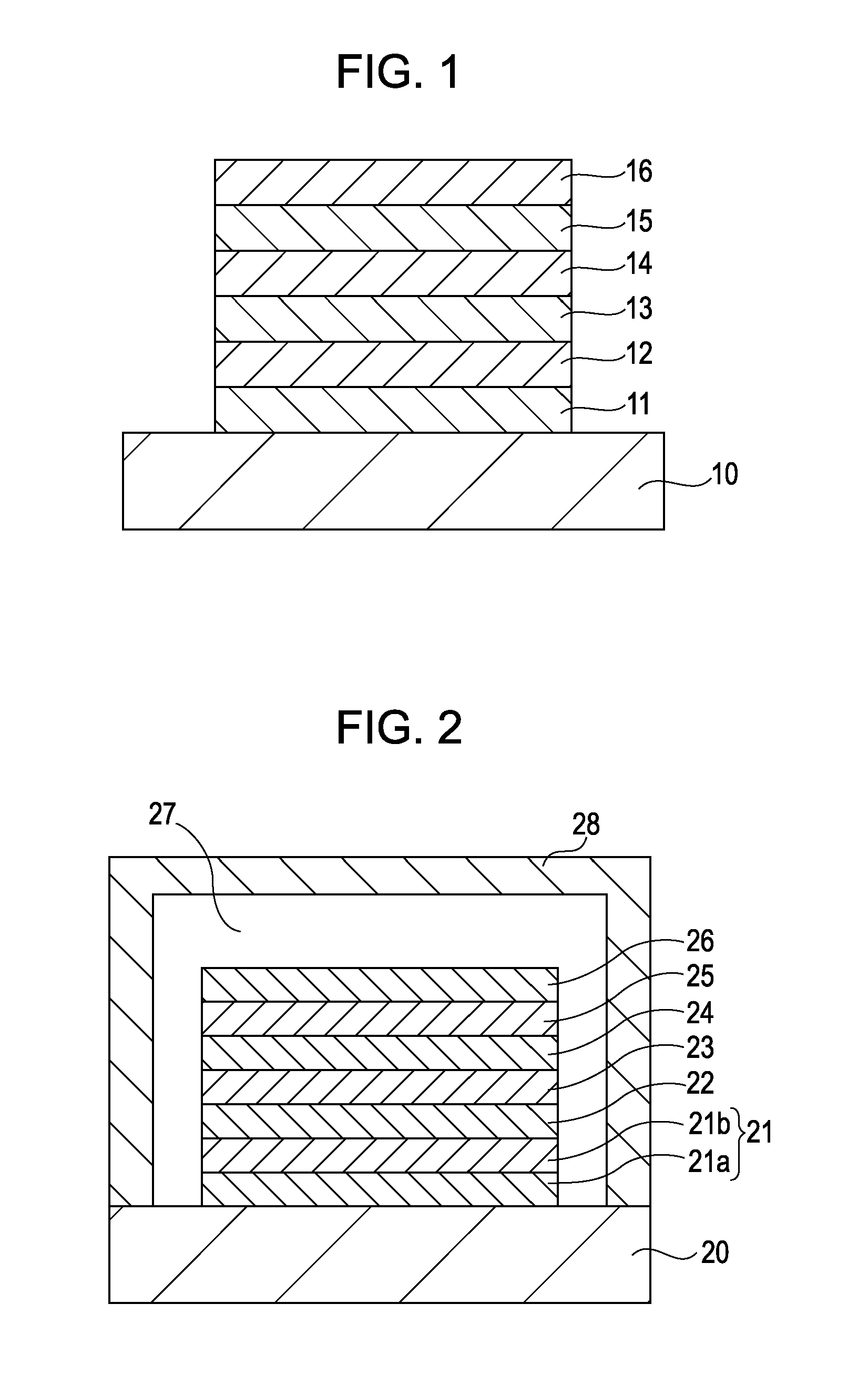Organic light-emitting element and light-emitting device using the same
a technology of light-emitting elements and light-emitting devices, which is applied in the field of light-emitting elements, can solve the problems of insufficient luminous efficiency, rare light-emitting materials, and insufficient properties of materials, and achieves high luminous efficiency and favorable emission color.
- Summary
- Abstract
- Description
- Claims
- Application Information
AI Technical Summary
Benefits of technology
Problems solved by technology
Method used
Image
Examples
example 1
[0073]An organic light-emitting element shown in FIG. 2 was prepared in the following process.
[0074]Aluminum alloy (AlNd) was deposited to a thickness of 150 nm on a substrate 20 by sputtering to form a reflection layer 21a, and ITO was deposited to a thickness of 10 nm on the reflection layer 21a by sputtering to form a transparent electroconductive layer 21b. The resulting substrate was subjected to ultrasonic cleaning with isopropyl alcohol (IPA) and boiling cleaning, followed by drying. After UV / ozone cleaning, organic compounds were deposited by vacuum vapor deposition as below.
[0075]First, a compound expressed by Chemical Formula 1 was deposited to a thickness of 30 nm to form a hole transport layer 22 at a vacuum of 1×10−4 Pa and a deposition rate of 0.2 nm / s.
[0076]Then, a blue light-emitting layer 23 exhibiting the PL spectrum shown in FIG. 4 was formed to a thickness of 35 nm by vacuum vapor deposition at a vacuum of 1×10−4 Pa and a deposition rate of 0.2 nm / s.
[0077]Subsequ...
example 2
[0083]The organic light-emitting element of Example 2 is different from that of Example 1 in that the transparent electroconductive layer 21b and the hole transport layer 22 were formed to thicknesses of 100 nm and 52 nm, respectively. The other layers have the same thicknesses as in Example 1. Table 8 shows the light emitting characteristics of the organic light-emitting element of Example 2.
TABLE 8Luminous efficiency2.1 (cd / A)ChromaticityCIEx0.125coordinatesCIEy0.080Maximum peakInterference intensity distribution λ1440 nm wavelengthPL spectrum λ2475 nm EL spectrum λ3460 nm Difference in peak|λ2 −λ1|35 nmwavelength|λ2 −λ3|15 nmHalf-widthInterference intensity distribution65 nmPL spectrum46 nm
[0084]As shown in Table 8, the organic light-emitting element of Example 2 emitted a deepest blue color with CIEy of 0.08 of the luminescent chromaticity. The color of the EL spectrum extracted from the element had CIE chromaticity coordinates of (0.125, 0.080), and the deviation Δxy from the b...
example 3
[0087]The organic light-emitting element of Example 3 is different from that of Example 1 in that the reflection layer 21a was formed of a silver alloy (AgPdCu) to a thickness of 150 nm, and that the hole transport layer 22 and the electron injection layer 25 were formed to thicknesses of 124 nm and 20 nm respectively. In addition, the second electrode 26 was formed of silver, instead of ITO, to a thickness of 20 nm in a sputtering apparatus. The other layers of the element were formed of the same materials to the same thicknesses as in Example 1. Table 9 shows the light emitting characteristics of the resulting organic light-emitting element of Example 3.
TABLE 9Luminous efficiency3.2 (cd / A)Chromaticity coordinatesCIEx0.108CIEy0.116Maximum peakInterference intensity distribution λ1460 nmwavelengthPL spectrum λ2476 nmEL spectrum λ3468 nmDifference in peak|λ2 −λ1| 16 nmwavelength|λ2 −λ3| 8 nmHalf-widthInterference intensity distribution 46 nmPL spectrum 46 nm
[0088]As shown in Table 9,...
PUM
 Login to View More
Login to View More Abstract
Description
Claims
Application Information
 Login to View More
Login to View More - R&D
- Intellectual Property
- Life Sciences
- Materials
- Tech Scout
- Unparalleled Data Quality
- Higher Quality Content
- 60% Fewer Hallucinations
Browse by: Latest US Patents, China's latest patents, Technical Efficacy Thesaurus, Application Domain, Technology Topic, Popular Technical Reports.
© 2025 PatSnap. All rights reserved.Legal|Privacy policy|Modern Slavery Act Transparency Statement|Sitemap|About US| Contact US: help@patsnap.com



